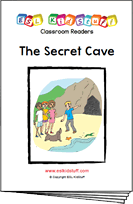Demonstrative pronouns lesson plan
Stand-alone lesson ESL kids lesson plan
Lesson plans for ESL kids teachers

Demonstrative pronouns
In this lesson, students practice using the demonstrative pronouns (this / that / these / those) to point out specific things. They play a fun board game, read a story and complete a demonstrative pronouns worksheet.
Members get accompanying worksheets and classroom reader.
Download materials:
Our lesson plans are FREE!
Sign up for accompanying:
✔ worksheets
✔ homework sheets
✔ craft sheets
✔ flashcards
✔ song downloads & videos
✔ classroom readers & videos
Click to see lesson details, materials and supplies
Time: 40 mins – 1 hour
Objectives: Pointing to specific things using “this / that / these / those”.
Structures: “What is this / that / that over there?”, “What are these / those / those over there?”.
Target vocabulary: various classroom objects.
Lesson materials
Printables:
- Demonstrative pronouns structures cards
- this, that, these, those board game
- this, that, these, those 1 worksheet
- this, that, these, those 2 worksheet
- Reader worksheet
Readers:
- The secret cave
Additional materials:
- This, that, these, those vocab crossword
- This, that, these, those vocab word search
- This, That, Those, These worksheet
Supplies:
- [hide_on_uk]colored[/hide_on_uk][hide_on_us]coloured[/hide_on_us] pencils
- objects (such as plastic farm animals) for introducing the demonstrative pronouns
- dice – enough for one per group of students
- counters – enough to give one to each student
- board with marker / chalk
Your students will have heard you use demonstrative pronouns in every lesson as part of your classroom discourse (e.g. “What is this?”, “Can you pass me that ball?”, etc.). In this lesson, students can practice using these pronouns correctly to point specific things out.
Demonstrative pronouns are words that point to specific things. For example, “This is a pen”.
These pronouns show the relationship between the person speaking and the object:
- this / these: object or objects near the speaker (often within touching distance)
- that / those: object or objects futher away from the speaker (often out of touching distance)
- that over there / those over there: object or objects far away from the speaker
Demonstrative pronouns differ in singular and plural forms:
- What is this? / This is a pen. (singular form, with verb “to be” in singluar)
- What are these? / These are pens. (plural form, with verb “to be” in plural)
- What is that? / That is a pen. (singular form, with verb “to be” in singluar)
- What are those? / Those are pens. (plural form, with verb “to be” in plural)
- What is that over there? / That over there is a pen. (singular form, with verb “to be” in singluar)
- What are those over there? / Those over there are pens. (plural form, with verb “to be” in plural)
Lesson procedure:
Warm up and maintenance:
The beginning of your lesson is extremely important: this is where you set the tone of your lesson and get everyone in the right frame of mind for learning English. It is also an opportunity to check homework and review previous lessons.
Click for warm up suggestions for the start of your lessons
These activities can be done in the following order at the start of your lesson:

1. Greetings and name tags
Greet the students by name as they enter the classroom and gesture for them to sit down. Before class prepare some blank name tags (stickers or pin-on tags). Give these out and have everyone write their names and put their tags on. If you use pin-on tags, you can keep and give out every class.

2. Homework check
Check each student’s homework set in the last lesson. Ask each student some questions about their homework worksheet (e.g. “what [hide_on_uk]color[/hide_on_uk][hide_on_us]colour[/hide_on_us] is it?”), give lots of praise, and then put some kind of mark on the homework sheet (e.g. a sticker, a stamp or draw a smiley face). Finally, tell your students to put their homework back into their bags.
3. Review past lessons
Reviewing past lessons is very important – students need constant practice of new vocab, structures, songs, games and so on. Always review parts of your last lesson as well as some parts from other previous lessons. You can spend 5-10 minutes reviewing – it’s fine to recycle games and activities from your past lessons to review as kids enjoy playing familiar games (although be careful not to play a game to death!). See the section “Other ideas to include in your warm” below for ideas.
You can also include review activities in the main body of your lesson. Kids can have short attention spans so it’s good to be able to pull out lots of activities during different stages of the lesson.
Other ideas to include in your warm up:
Ball pass questions
This is good to review questions from previous lessons. Get everybody standing in a circle.
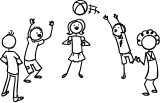
Round 1:
Take a ball and hold it and say, “My name is (you name)”. Then throw the ball to one student and say, “What’s your name?”. Students throw the ball around randomly, saying their names and asking for names.
Round 2:
This time ask a review question, e.g. “How many tables are there?”. Then throw the ball to a student who should answer, “There are (6) tables”. Help if necessary. Then that student throws the ball to another student and asks a “How many …?” question. Continue so everyone has a go. You can have multiple rounds with different topic questions.

Play “Spin the bottle”
Sit students in a circle with a bottle in the middle. Teacher spins the bottle. When it stops spinning the student it is pointing to has to answer a question. If the answer is correct then that student can spin the bottle. This is a good class warm up activity (e.g. How are you? What’s your [hide_on_uk]favorite[/hide_on_uk][hide_on_us]favourite[/hide_on_us] food? How’s the weather today?, etc.

Play “Vocabulary basketball”
This is a fun game which reviews vocabulary from previous lessons. You will need a basket (a trash can) and 2 balls (or 2 pieces of A4 paper scrunched up into balls).
Form 2 teams and line them up so that two players from each team are facing the front with the basket in front of them. Let both players throw their ball – if they get their ball into the basket they can try and win a point by giving the correct answer to a question the teacher asks. This can be an actual question (e.g. What are you wearing?) or a flashcard (What’s this?). Then they go to the back of the line. At the end, the team with the most points is the winner!
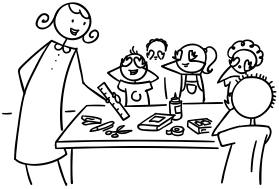
Play “What’s missing?”
This is a fun review memory game – students will have to try to remember review objects from previous lessons (e.g. classroom stationery). Lay the objects out on a table for all to see. Allow the students a minute to memorize the positions of the objects. Remove an object and hold it behind your back. Say, “Open your eyes!” – the first student who can shout out the missing object wins a point for his/her team. Play for all the objects.
Finally, calculate which team has won the most points and give them a round of applause.

Play “Quiz game show”
This is a fun quiz game, like a simple version of a TV game show. Draw some circles on the board and randomly write numbers 1, 2 or 3 in each circle. These will be points.
Put students into teams. Then ask the first team to choose a number – 1 is an easy question (e.g. “Do you like bananas?”) and 3 is a difficult question (e.g. point at a clock and ask, “What time is it?”). 2 will be in between in terms of difficulty. When the question has been answered correctly, erase that number circle. Play until all the number circles are gone – the team with the most points is the winner!

Read a classroom reader again
As you progress through the lessons you will start to build up a catalog of classroom readers (see our Readers download page at https://www.eslkidstuff.com). Kids love going back to old stories and reading through them again. Invite a student to pick a classroom reader and read through it as a class. Make the story as interactive as possible by asking questions (e.g. what [hide_on_uk]colors[/hide_on_uk][hide_on_us]colours[/hide_on_us] there are, the names of different objects, etc.) and getting students to speculate what is going to happen next in the story.

Talk about the weather (do after you have taught the weather lesson plan).
- Prepare a weather board. Before the first class prepare a piece of cardboard and cover it with felt – you are going to pin this to the wall. If you can, try and get blue felt (to represent the sky). Write at the top in large letters, “How’s the weather today?”. Below that write “Today it’s”. Cut out weather pictures (such as our weather flashcards) and stick some velcro on the back. Arrange the weather pictures around the edge of the board and then put the board on the wall of your classroom. You can now use this weather board at the beginning of every lesson.
- Ask about the weather. Ask, “How’s the weather today?” and have students put up their hands. Allow one weather condition per student (e.g. “It’s rainy”) and have each student come up and put a weather picture on the weather board.
- Introduce more weather vocabulary. Depending on weather conditions, you can introduce more weather words (with pictures … you can get students to draw them), such as:
- stormy
- misty
- showery
- freezing
- humid
- frosty
- icy
- drizzly
New learning and practice:
1. Introduce the demonstrative pronouns
We’ll need to be well organized when presenting the different demonstrative pronouns to your class – you want to make sure the structures are clearly explained and easy to understand for your students. If this section of the lesson goes well the other parts will follow easily and you’ll have a lot of fun.
Before class, cut out the “Demonstrative pronouns structures cards”. Also prepare 9 objects – I use 9 plastic animals to make it fun, but anything will do, e.g. 9 pens, 9 fruit, 9 toy vehicles, etc.
Start the lesson by standing at the front of the class. Tell everyone to stand up and come up to the front of the class, standing behind you. This will result in a bit of mayhem. Make sure you make enough space between you and the wall for everyone to fit comfortably in.
STAGE 1
You will now have any empty classroom of desks and chairs in front of you. Take out one of your objects (I’ll use plastic animals – in this case a toy cat) and place it on the desk in front of you. Point to it and ask the class “What?” and elicit,“A cat”.
Next place a cow on a table in the middle of the classroom and again elicit what it is simply by saying “What?” and pointing.
Finally, place an elephant on the table at the far end of the classroom and elicit what it is.
Now, take out the 3 “What is” cards from your demonstrative pronouns card set and put each one next to each of the 3 animals. Then go back to the front of the class and show the three cards for “this?”, “that?”, “that over there?”. Give each card to a student and ask them to place the cards where they think they belong to complete the questions. You can give help if necessary, but I usually find that some students in the class will be able to direct the students correctly.
By this point you should have the cards laid out in the classroom as follows:

Next take out the “This is a/an”, “That is a/an” and “That over there is a/an” cards and ask three different students to place them next to the questions on the desks. You should end up as follows:
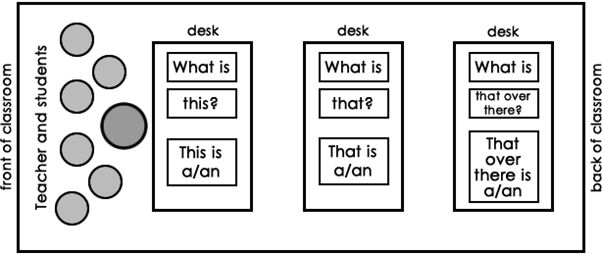
Now test students by asking questions and pointing, such as:
Teacher: Miki, what is that? (pointing at the cow)
Student: That is a cow.
Teacher: Good! Freddy, what is this? (pointing at the cat)
Student: This is a cat.
etc.
Put students in pairs and give them a couple of minutes asking and answering the questions for the animals on the desks.
STAGE 2
Now we’ll introduce plurals. Take out two of the same animal (e.g. two dogs) and place them on the nearest table. Elicit the animals (“What?”, “Dogs.”). Then do the same for the other two desks (e.g. 2 horses and 2 monkeys) until you have two pairs of animals on each desk.
Take out the three “What are” cards and also the cards “these?”, “those?” and “those over there”. Ask three students to place the cards on the correct tables.
Finally, ask three more students to place the “These are”, “Those are” and “Those over there are” cards on the correct desks.
End by modeling some conversations, for example:
Teacher: Andre, what is this? (pointing at the cat)
Student: This is a cat.
Teacher: Good job! Sara, what are those over there? (pointing at the 2 monkeys)
Student: Those over there are monkeys.
etc.
Then put students into pairs to practice asking and answering the questions.
2. Arrange the board with structures
Give students some tape and ask them to stick the demonstrative pronoun cards onto the board in a logical way, for example:
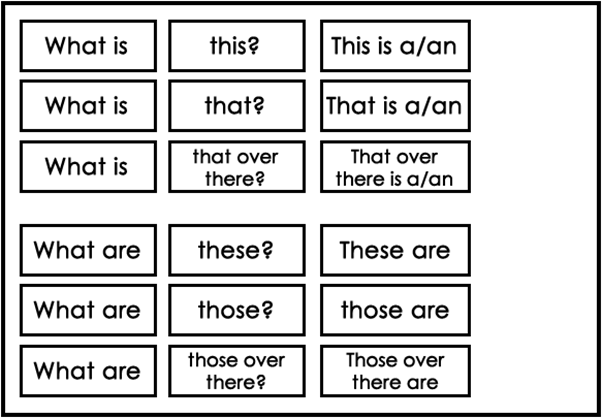
Then in the space to the right of each sentence ask different students to draw the animals that were used (e.g. a cat next to “This is a/an”, a cow next to “That is a/an”, etc.).
3. Play “All around the classroom”
Sit students back down at their desks and put them into pairs. Pairs take it in turns to ask questions and point to things around the classroom, such as:
Student A: What is that over there?
Student B: That is a book.
Student A: No, next to the book.
Student B: Um, that is a pencil case.
Students A: Yes, that’s right!
As the students are speaking, circulate around the class and help out with vocabulary and structures.
Let the activity run for around 5-10 minutes. Then do a class check by asking different pairs to stand up and show the class one of their conversations.
4. Play the “this, that, these, those board game”
Before class, print out enough board games for each group for 2-4 students (if possible, blow it up to A3 size). Each group will need one dice and a counter per student. Place students in groups of 2-4 around a table and give out the board games. As a class, read through the instructions and make sure everyone is clear of how to play.
As everyone plays the game, circulate around the class checking for correct usage.
5. Do the “this, that, these, those 1” worksheet
Give out the worksheet and have everyone fill in the blanks. Then check answers as a class.
6. Read classroom reader “The secret cave”
Before class, download and print off the reader “The secret cave”. As you go through each page, indicate what the kids in the story are pointing at and ask your students which demonstrative pronoun should be used and also what it is they are actually pointing at, for example:
Teacher: (reading from page 3 and 4) “Suddenly, Sue noticed something. “What’s …?” (pause as you wait for someone to say the missing word).
Student: “… this?”
Teacher: Yes, that’s right! (reading) … “What’s this?, she asked”. What do you think it is?
Student: A tail!
Teacher: Let’s check … (reading) … “It looks a bit like a tail”. Yes, well done!
Continue through the story, getting everyone to say the pronouns and guess what the things in the cave are.
After reading the story, give out a reader worksheet to each student and have pairs or small groups fill in the answers. Finally, quickly read through the story again to check the answers.
Alternatively, watch our video version of the reader (Internet connection required).
7. Play “Run and touch the object”
Let’s finish with a fun, high-energy game. Get everyone to stand up. The teacher says things that are in the classroom using the demonstrative pronouns and students must run and touch those objects. So, for example, if the teacher says, “These are pencils” students must touch the pencils nearest the teacher, as it is all in relation to the location of the teacher. Other ideas:
- Those are curtains.
- This is a dictionary.
- That over there is a window.
- Those over there are scissors.
- These are desks.
- etc.
Wrap up:
Assign homework: “this, that, these, those 2” worksheet
Click for wrap up suggestions for the end of your lessons

1. Assign homework
Each week give out a homework worksheet for your students to take home. Hold up the homework worksheet and model how to do it. Give out the worksheets and say, “Put your homework in your bags”.

2. Do “Quick check”
Time to leave the class. Make sure everything is put away and the students have gathered their belongings. Have them line up at the door and place yourself between the door and the students. For each student check one new word or phrase, for example:
- hold up an object or flashcard (such as an item of clothing) and ask, “What’s this?”
- ask a question from the lesson (e.g. “Where do you live?”, “Do you like bananas?”, “Can you play chess?”, etc.)
When they give you the correct answer say goodbye and let them leave. If their answer is wrong, have them go back to the end of the line – they will have to try again once they reach the front!
Other lesson plans
Actions, verbs & tenses:
- Can – for ability
- Morning routines
- Daily routines & times of the day
- Actions – Present continuous
- Future plans using “going to”
- Past tense activities – Regular verbs
- Past tense activities – Irregular verbs: Part 1
- Past tense activities – Irregular verbs: Part 2
Adjectives:
- Describing people
- Describing things
- Comparing things (Comparative adjectives)
- Comparing things (Superlative adjectives)
Adverbs:
Alphabet:
Animals:
Body:
Classroom:
Clothes:
Colors:
Colours:
Directions:
Family:
Feelings & emotions:
Food:
Health & sickness:
Holidays & festivals:
Jobs:
Likes, dislikes & favorites:
Likes, dislikes & favourites:
- Likes & dislikes
- [hide_on_uk]Favorites[/hide_on_uk][hide_on_us]Favourites[/hide_on_us] and asking why
Nature & Our world:
Numbers:
Places & where we live:
Prepositions of location:
Pronouns:
Shapes:
Shopping:
Sports:
Time, days, months, seasons:
Toys:
Transport & travel:
Weather:


